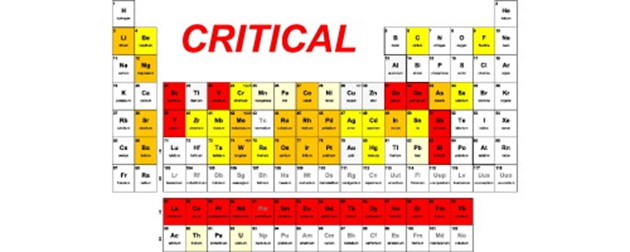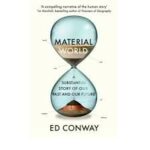Written by Jonathan Moseley, April 17th 2024
No relation to the Madonna song, but rather the title of a book by Ed Conway, an economist and journalist, regarding the Material World in which we live. And if like me, you have a general interest in chemistry, as well as some interest in economics and history (ancient and modern), then this is an excellent read. So whilst this isn’t intentionally a book review, it is a review of a book.
Conway structures his book around what he identifies as six critical materials which have contributed to and made possible the modern material world. Intriguingly, these aren’t the ones that usually appear in colour-coded periodic tables (eg. see below) – they are instead sand, salt, iron, copper, oil and lithium – with three very readable chapters on each. (Albeit, Conway does take a non-chemist’s generic approach to “salt” and discusses three separate salts, but we’ll have to let him off that! And who knew common table salt was so interesting – or historically important – apparently Britain’s famously straight Roman roads were built on “salt paths” used by Celtic salt merchants for centuries beforehand).

(reproduced from: Ore Geology Reviews, 2017, 86, 924-938 (Mudd, Jowitt, Werner))
Conway is an economist, not a chemist, so what is he getting at? Well, a repeated theme is that because these materials are all so plentiful, ubiquitous and cheap, we don’t notice their significance – yet without them there would be no modern material world. Sand and cement make concrete (known from ancient times to the Romans with a recipe that has still not been fully reproduced), which when reinforced by iron provides the built environment, whilst copper within it provides the communication network (the “nerves”). The energy for all the processing required is mainly provided by oil and its associated materials.
Continuing with sand for the moment, I always thought chemically that meant silicon dioxide (i.e. silica, SiO2), but apparently it refers to the particle size of any mineral (0.0625 to 2 mm on one commonly used scale; something to note in our crystallisation course); and those beautiful white beaches on tropical islands aren’t composed of silicon dioxide either – it’s calcium carbonate (CaCO3), and knowing what formed it would put you off your cocktail… But here Conway does actually mean SiO2, from which the ancient world produced an early manufactured material i.e. glass – from which lab chemists make glassware, purify materials by chromatography using granular SiO2, and analyse the products with instruments equipped with high quality glass lenses.
Although SiO2 sand is ubiquitous, high quality SiO2, free of iron and other coloured impurities, comes only from limited locations. From this, lenses were first produced which facilitated the discovery of Jupiter’s moons (an important discovery in its own right), but also spectacles for those of us with poor eyesight. These enabled artisans, craftsmen and professionals to have longer and more productive working lives, whilst also ensuring greater continuity and dissemination of their knowledge. Improved and cheaper glass meant more light within buildings to work during the day, and more light from lanterns in the evenings. Smokeless light oil contributed later to this virtuous cycle, before soon being replaced by electricity, providing vastly more light on demand, but dependent on a copper-based infrastructure. Similar discoveries, innovations and social changes feature for the other materials discussed.
In this discussion of glass, I haven’t mentioned the various important processes that were discovered, made practical, scaled-up and improved – and then optimised yet further – or how they were adapted to other developments in technology – all driving production efficiencies up and costs down (i.e. standard “process development”).
Conway helpfully emphasises not just the financial cost of such processes, but also the energy cost (something we cover in our Chemical Development course). Glass manufacture is hugely energy intensive. Wood was used initially, but one quickly runs out of trees; coal is better, and oil better still, because it contains so much more chemical energy and is easier to collect and transport (although unbelievably, the world is still digging up almost as much coal as oil at present). Electricity is even better of course, but not perhaps if it has come from a coal-fired power station. This same energy hierarchy has also applied to the smelting of iron ore over the centuries, so that now electrical arc furnaces are often used.
The chapters on the salts are of perhaps of most immediate interest to chemists. Returning to common table salt (sodium chloride or halite, NaCl), electrolysis in water gives us three essential reagents of the modern chemical industry – chlorine (Cl2), hydrogen (H2) and sodium hydroxide (NaOH).
2 NaCl + 2 H2O à Cl2 + H2 + 2NaOH
Potassium nitrate (saltpeter, KNO3) is produced by the hugely important Haber-Bosch process on massive scale (incidentally catalysed by iron), because we have actually exhausted all worthwhile sources. This is now essential for fertiliser to feed the world’s population – and less helpfully for explosives, which we have yet to do without…
N2 + 3 H2 à 2 NH3 ( + O2 à HNO3 à KNO3 )
Turning to the modern era, in the 19th century much of the world’s copper was mined from copper-rich ores in Cornwall and north Wales and processed in south Wales, equidistant between the two, and rich in coal for the energy-intensive processing required. However, this copper wasn’t pure enough for electrical purposes and vast new sources had to be found, especially as an early adopter like the USA electrified its infrastructure over significant distances. The world won’t run out of copper, but even the ores of copper-rich Chile and Peru are now much thinner, requiring more energy for mining – whilst China now completes the majority of the energy-intensive processing (the situation is similar for rare earth elements on the basis of geological availability, I believe). The same could be said of lithium, the only “modern” critical material in Conway’s list – but I’ll let you read about that yourself.
Returning briefly to SiO2 sand, this is of course the source of metallic silicon (Si) required for silicon chips. And as with glass, it transpires that the best “sand” for the very best silicon chips comes from only a few sources. This undergoes multiple rounds of processing in the USA, Germany and elsewhere, before the finally pure silicon is sent to Taiwan for producing into the highest quality computer chips – before the silicon ever gets near a computer.
What strikes me in all this is the inter-connectedness of our material world (and not meaning the copper infrastructure of modern communications), but rather how every material and process depends upon and is supported by every other. This has resulted in some bizarre transactions. For example, at the start of the First World War, Britain sold potassium nitrate for explosives to Imperial Germany in exchange for quality lenses for telescopes and binoculars (you couldn’t make this up!) before Haber’s process alleviated Germany’s nitrate shortage and Britain re-activated its moribund domestic glass industry. That was in 1914. Today supply chains are vastly more inter-connected, as we learnt during the pandemic, and for high-end applications like computer chips, there exist significant vulnerabilities – if just one mine is flooded, or one factory burns down, the entire world supply may falter immediately.
But I am also struck by both what and how much chemists (and other physical scientists and engineers) have contributed to and made possible the modern world. I think chemists are generally not very good at illustrating their contributions to society, but the few examples above exemplify how innovation in materials has built, illuminated, connected and fed the modern world, not just facilitated the specifics of the modern chemical industry, along with usually positive social changes.
Overall, this is an excellent and highly recommended read, which fully deserves the accolades heaped upon it (by worthier readers than me). It is full of fascinating facts and stories about chemistry, history and economics and the relationships between them, and written in an easily accessible form which should be of interest to all, not just to chemists.

Ed Conway “The Material World” (2023) 443 p (h/b) ISBN 978-0-75355-915-4
Training courses mentioned can be found at: https://www.scientificupdate.com/training/courses/








